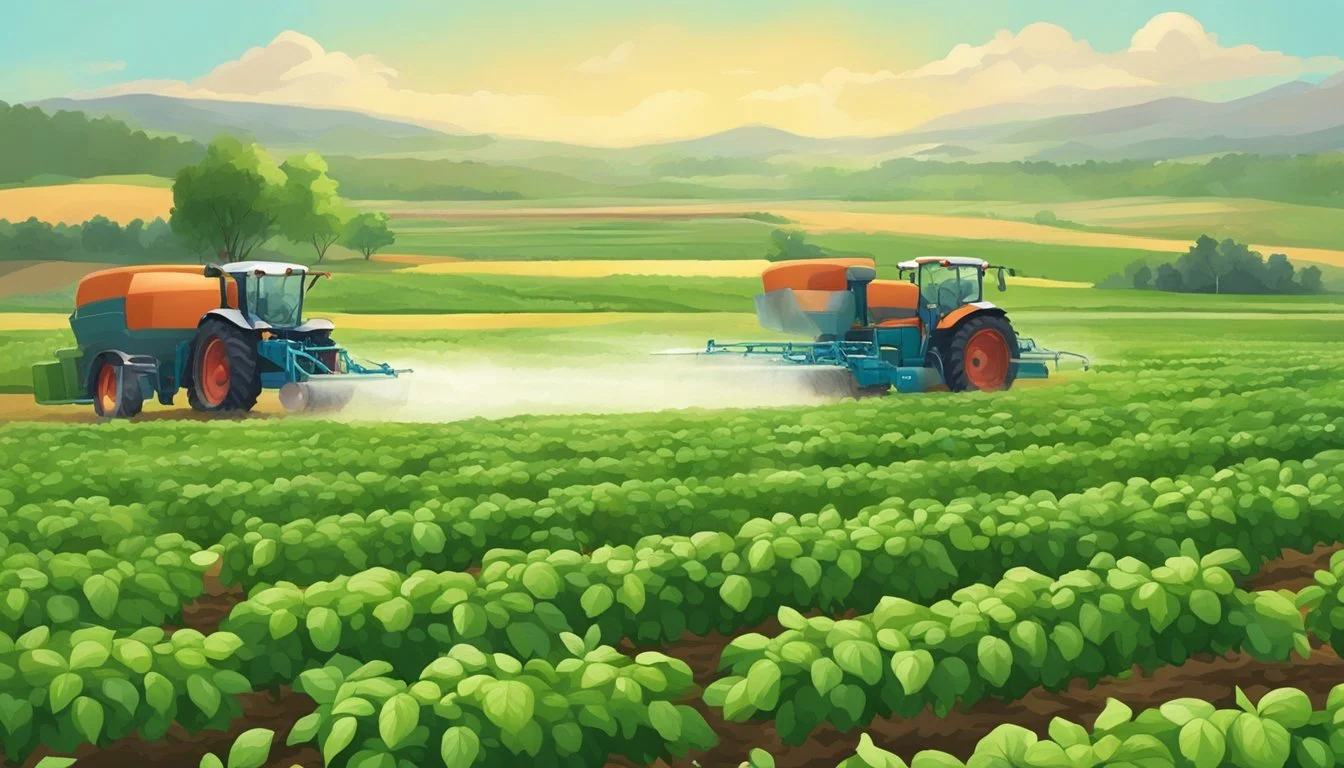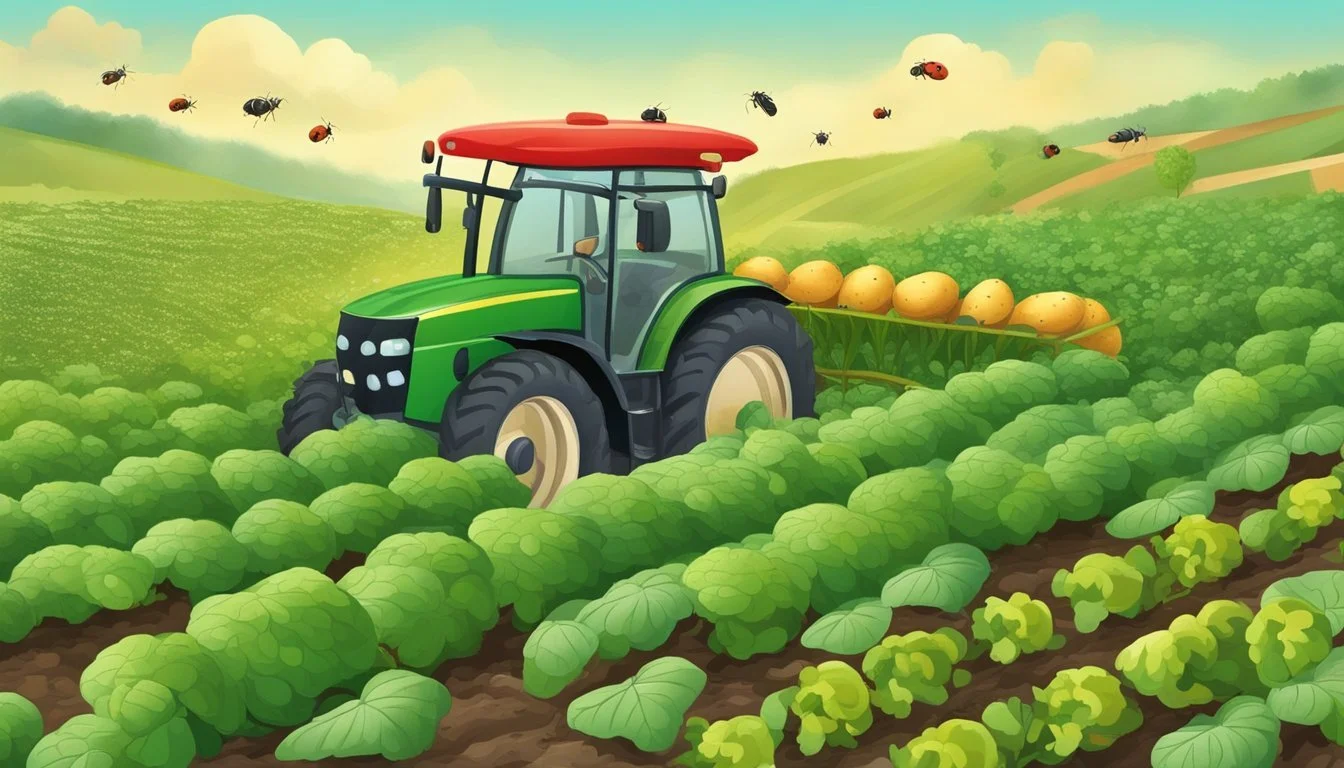Pest Control for Potato Fields
Effective Strategies for Healthy Crops
Effective pest control is a critical aspect of successful potato production. Potato fields are susceptible to a variety of pests that can affect both the yield and quality of the crop. Key pests include the Colorado potato beetle, potato leafhopper, and wireworms, all of which can inflict significant damage if not properly managed. To safeguard crops, farmers employ a range of integrated pest management (IPM) strategies. These strategies blend regular field scouting, sanitation measures, and targeted use of chemical controls with an eye toward environmental impact and sustainability.
The implementation of pest management in potato fields requires careful consideration and knowledge of pest behavior and lifecycles. For instance, Colorado potato beetle adults are known to overwinter in the soil and migrate to potato crops in the spring. Recognizing such behavior patterns is essential for timely interventions. Additionally, cultural methods, such as crop rotation and the selection of resistant potato varieties, can further enhance pest control measures. For example, the potato variety Delus has shown high resistance to potato leafhoppers, proving that the right variety selection can significantly reduce the need for chemical treatments.
Chemical control remains a commonly used option for managing pest populations in potato production, necessitating up-to-date knowledge on effective insecticides, herbicides, and fungicides. Chemical treatments should be based on current registration labels and tailored to the specific pests present in the field. It is also important for growers to consider the timing of applications to maximize efficacy and minimize any adverse effects. As such, a robust pest management program is vital to ensure that potato crops are protected throughout the growing season, leading to a successful harvest.
Understanding Potato Pests
Effective pest management is integral to successful potato farming, as various insects can significantly impact crop yield and quality. This section will discuss the life cycles of common pests, their effects on potato crops, and methods to identify their presence.
Common Pests and Their Life Cycles
Colorado Potato Beetle (Leptinotarsa decemlineata):
Eggs: Yellow-orange, found on the underside of leaves.
Larvae: Reddish-purple caterpillars with black spots.
Adults: Striped yellow and black beetles.
Aphids:
Nymphs: Born live, resemble smaller versions of adults.
Adults: Green, black, or pink, often wingless.
Potato Leafhopper (Empoasca fabae):
Nymphal Stage: Green and wingless, smaller than adults.
Adults: Green, wedge-shaped insects.
Wireworms/Grubs:
Larvae: Long, slender, brownish, and hard-bodied.
Adults: Click beetles, which are brown or black.
Potato Tuberworm (Phthorimaea operculella):
Larvae: Pale yellow caterpillars with brown heads.
Adults: Small grey moths with a wingspan of 12mm.
European Corn Borer (Ostrinia nubilalis):
Larvae: Creamy white to pink with brown heads.
Adults: Yellow to brown moths.
Impact of Pests on Potato Yield and Quality
Defoliation: The Colorado potato beetle causes severe defoliation, which can decimate crop yield.
Hopperburn: Potato leafhoppers cause "hopperburn," a crisping of leaf edges that impedes photosynthesis.
Tuber Damage: Wireworms and tuberworms bore into tubers, affecting quality and storage life.
Secondary Diseases: Openings caused by pests like the European corn borer can allow diseases to enter.
Identifying Pest Presence in Potato Fields
Visual Inspection: Regular scouting for egg clutches, larvae, and adult insects on leaves.
Foliage Damage: Look for chewed leaves and "hopperburn."
Tuber Inspection: Examine harvested tubers for entry holes and tunnels.
Note: Early detection is crucial for effective management of insect pests in potato fields.
Pest Management Strategies
Effective pest control in potato fields is crucial for ensuring healthy crop yields and sustainable agriculture practices. The strategies range from the application of chemicals to the use of beneficial organisms and integrated methods that combine multiple approaches.
Chemical Control Methods
Chemical control employs pesticides such as insecticides, herbicides, and fungicides to prevent damage by pests. Insecticides can target specific pests, like the Colorado potato beetle, to reduce their impact on crops. Fungicides are used to protect potatoes (What wine goes well with potatoes?) from fungal pathogens, and herbicides manage weed populations that compete with potato plants for resources. It is important to follow pesticide recommendations carefully to maximize effectiveness and minimize harm to the environment.
Biological Control Options
Biological control options utilize living organisms like predators, parasites, and microbial agents to suppress pest populations. An example is Bacillus thuringiensis (Bt), a naturally occurring bacteria that produces toxins lethal to certain insect larvae. Other biological agents include predatory insects, like lady beetles, which consume large numbers of aphids, and birds that can feed on various potato pests.
Integrated Pest Management (IPM)
Integrated Pest Management (IPM) is a holistic approach that combines multiple control options to manage pest populations with the least possible harm to people, property, and the environment. It involves monitoring pest levels, using economic thresholds to determine when management is needed, and applying a mix of biological, cultural, physical, and chemical tactics to keep pest populations low. IPM encourages the use of environmentally sensitive approaches, including the preservation of beneficial organisms that serve as natural enemies to pests.
Cultural and Preventive Measures
Implementing cultural and preventive measures is critical in managing pest infestations in potato fields. Such measures can enhance the overall health of the crop and soil, thereby reducing reliance on chemical controls, and maintaining or even increasing yield.
Crop Rotation and Soil Management
Crop rotation is a fundamental agricultural practice that disrupts the life cycles of pests. By planting a non-host crop after potatoes, they discourage pest populations from becoming established. Managing the soil surface through timely cultivation helps eliminate pests that may overwinter in the soil.
Field Sanitation and Weed Control
Maintaining field hygiene by removing crop debris post-harvest can significantly reduce pest habitat. Control of weeds is equally crucial, as they can harbour pests or serve as alternate hosts. Regular field sanitation practices and diligent weed control are important preventive measures against pest infestation.
Use of Resistant Varieties
Selection of potato varieties resistant to specific pests can greatly reduce the potential for infestation. Use of resistant varieties is an essential aspect of pest management, offering an environmentally friendly alternative to chemical controls and helping maintain field yield and health.
Incorporating these cultural and preventive strategies forms the cornerstone of effective pest management in potato cultivation.
Environmental Considerations and Compliance
Environmental awareness is crucial in the management of potato pests. It involves understanding the delicate balance between effective pest control and minimizing the unintended effects on non-target organisms and compliance with stringent regulatory guidelines.
Pesticide Impact on Non-target Species
Pesticides, designed to target specific pests, can inadvertently affect other organisms. Endangered species and beneficial insects might be put at risk through exposure to fumigants and other chemical controls. Studies have shown that broad-spectrum pesticides can harm non-target species, which underscores the necessity for targeted pesticide application and conservation of biodiversity.
For instance, the Colorado potato beetle and the green peach aphid are known to wreak havoc in potato fields, and while pesticides are an effective means of control, their use must be carefully managed to protect non-target organisms in the ecosystem.
Regulatory Guidelines for Pesticides
Regulatory compliance is non-negotiable; it safeguards the environment from the adverse effects of pesticide use. Pesticide regulations are put in place to mitigate environmental impact and ensure the safety of endangered species. These regulations dictate the permissible chemicals, their application rates, and timing to minimize the ecological footprint.
Farmers and commercial growers are required to follow guidelines such as rotating fields and implementing integrated pest management strategies to align with environmental regulations. These measures not only adhere to the protection of natural habitats but also promote sustainable agriculture practices.
Emerging Threats and Research
The landscape of potato pest control is rapidly evolving due to global pest trends and breakthrough advancements in pest control technology. Stakeholders are actively seeking solutions to safeguard this staple crop.
Global Trends in Potato Pests
Potatoes are under threat from a diverse array of pests, with Europe seeing an influx of new challenges. The arrival of pests such as zebra chip disease vectors has triggered a response geared towards developing more effective control strategies. The global trend reflects a rise in non-native pests, demanding an escalated research effort to keep pace with these threats and formulate preemptive solutions.
Key Pests Identified:
Zebra chip disease vectors
Potato psyllid
Beet leafhopper
Advancements in Pest Control Technology
Research is yielding innovative technologies and strategies to combat emerging insect pests. Focus on host-specific factors and genetic analysis is leading to targeted approaches in pest control. Moreover, the exploration of biological controls through predatory arthropods in non-crop habitats is another area of significant advancement, contributing to a more sustainable pest management framework.
Technological Highlights:
Gut contents analysis for biological control
Genetic determinants of host colonization
This ongoing research is central to developing strategic responses not only in European contexts but also in addressing the global potato pest management needs.
Frequently Asked Questions
Pest management in potato farming is critical for protecting the crop from various insects and diseases. The following FAQs address common concerns regarding potato pest control.
How do farmers control potato bugs?
Farmers tackle potato bugs, such as the Colorado potato beetle, by integrating pesticide applications with crop rotation and using beetle-resistant potato varieties. The careful monitoring and timely application of insecticides also play a pivotal role.
What insecticide is best for potatoes?
The best insecticide for potatoes depends on the target pest and the level of infestation but often includes products containing spinosad or imidacloprid. For the most up-to-date and safe options, farmers refer to pest management guides from trusted academic sources.
What is the most common pest in potatoes?
One of the most common pests in potatoes is the Colorado potato beetle, which can cause significant damage to the foliage and disrupt crop growth. Effective management is crucial to prevent these pests from impacting yields.
How do you get rid of a potato bug infestation?
To rid a potato field of a bug infestation, one may need to employ a combination of tactics that include chemical controls with selected insecticides, manual removal of the beetles when practical, and cultural practices like crop rotation and the use of cover crops to break the pest's lifecycle.
What are natural methods for managing pests in potato fields?
Natural methods for pest management in potato fields include introducing beneficial insects that prey on pests, practicing crop rotation to disrupt pest breeding cycles, and growing pest-resistant potato varieties. Additionally, maintaining healthy soil helps support robust plant growth which can withstand pest pressures better.
Which pests are represented in potato pests pictures?
Pictures of potato pests often feature the Colorado potato beetle, aphids, potato psyllids, and leafhoppers. Identifying these pests through visual guides can enable more effective control measures specific to each type of pest.





